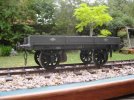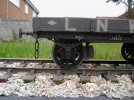Mike W
Western Thunderer
Seeing so many people post on here things they are making or have made, perhaps I have been remiss in not blowing the trumpet for Gauge 3. So, over time I aim to post a few pictures of random wagons!
First off, the very first Gauge 3 wagon I built. Its a long story, but I had a Christmas break with nothing to do, so shut myself away and on the spur of the moment made the body pattern for a very simple LNWR D1 single plank open, the plan being to have it cast in resin, keep a couple and sell the remainder of the batch to cover my costs. The transfers were made for me by Peter Chatham. The W irons are laser cut 20g steel, the axleboxes cast brass from a pattern made by Tim Hughes, and the whitemetal dummy leaf springs were cast by Adrian Swain. I think Adrian thought that the demand for Gauge 3 was very small, but to date I've had 5,000 of them cast! Did someone say Gauge 3 was a minority interest?

First off, the very first Gauge 3 wagon I built. Its a long story, but I had a Christmas break with nothing to do, so shut myself away and on the spur of the moment made the body pattern for a very simple LNWR D1 single plank open, the plan being to have it cast in resin, keep a couple and sell the remainder of the batch to cover my costs. The transfers were made for me by Peter Chatham. The W irons are laser cut 20g steel, the axleboxes cast brass from a pattern made by Tim Hughes, and the whitemetal dummy leaf springs were cast by Adrian Swain. I think Adrian thought that the demand for Gauge 3 was very small, but to date I've had 5,000 of them cast! Did someone say Gauge 3 was a minority interest?











